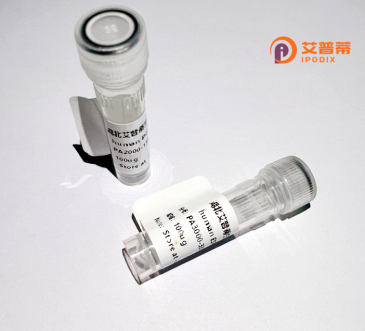
| 纯度 | >90%SDS-PAGE. |
| 种属 | Human |
| 靶点 | PDE3B |
| Uniprot No | Q13370 |
| 内毒素 | < 0.01EU/μg |
| 表达宿主 | E.coli |
| 表达区间 | 401-500 aa |
| 活性数据 | LTPFPGFYPCSEIEDPAEKGDRKLNKGLNRNSLPTPQLRRSSGTSGLLPVEQSSRWDRNNGKRPHQEFGISSQGCYLNGPFNSNLLTIPKQRSSSVSLTH |
| 分子量 | 36.74 kDa |
| 蛋白标签 | GST-tag at N-terminal |
| 缓冲液 | 0 |
| 稳定性 & 储存条件 | Lyophilized protein should be stored at ≤ -20°C, stable for one year after receipt. Reconstituted protein solution can be stored at 2-8°C for 2-7 days. Aliquots of reconstituted samples are stable at ≤ -20°C for 3 months. |
| 复溶 | Always centrifuge tubes before opening.Do not mix by vortex or pipetting. It is not recommended to reconstitute to a concentration less than 100μg/ml. Dissolve the lyophilized protein in distilled water. Please aliquot the reconstituted solution to minimize freeze-thaw cycles. |
以下是关于重组人PDE3B蛋白的3-4条参考文献示例,包含文献名称、作者及摘要内容概括:
1. **《Recombinant expression and functional characterization of human PDE3B: Role in cAMP signaling》**
- **作者**:T. Kitamura, M. Taira
- **摘要**:研究在大肠杆菌和哺乳动物细胞中重组表达人PDE3B,发现哺乳动物系统表达的蛋白具有更高活性。通过酶动力学分析,证实PDE3B的催化活性受胰岛素诱导的磷酸化调控,提示其在代谢调控中的潜在作用。
2. **《PDE3B regulates lipolysis and insulin signaling in adipocytes》**
- **作者**:Y.H. Choi, V.C. Manganiello
- **摘要**:利用重组PDE3B蛋白和脂肪细胞模型,证明PDE3B通过降解cAMP抑制脂肪分解。基因沉默实验显示,PDE3B缺失会增强胰岛素受体底物磷酸化,表明其协调胰岛素和cAMP信号通路的作用。
3. **《Structural insights into PDE3B activation by phosphorylation》**
- **作者**:S. Movsesian, E. Degerman
- **摘要**:通过冷冻电镜解析重组PDE3B的磷酸化形式结构,发现其N端调控结构域的构象变化可激活C端催化结构域,为设计选择性抑制剂奠定结构基础。
4. **《PDE3B as a therapeutic target in diabetic mice models》**
- **作者**:C. Rondinone, J. Snyder
- **摘要**:在小鼠中过表达重组PDE3B可改善高血糖和胰岛素抵抗,表明激活PDE3B或为糖尿病干预新策略,研究验证了其在肝脏糖代谢中的关键地位。
每篇文献侧重不同方向(表达方法、功能机制、结构解析及疾病应用),覆盖PDE3B研究的核心领域。
Recombinant human phosphodiesterase 3B (PDE3B) is a key enzyme involved in cyclic nucleotide signaling, specifically hydrolyzing the second messengers cAMP and cGMP to regulate cellular responses. As a member of the PDE3 subfamily, it features a conserved catalytic domain and unique N-terminal regulatory regions that mediate interactions with signaling partners. PDE3B is predominantly expressed in metabolic tissues (adipose, liver, pancreatic β-cells) and plays critical roles in insulin signaling, lipolysis, and energy homeostasis. Its activity is modulated by phosphorylation via insulin-Akt and adrenergic-PKA pathways, linking it to metabolic diseases like diabetes and obesity.
Recombinant PDE3B production employs expression systems (E. coli, mammalian cells) to generate purified protein for structural and functional studies. This enables precise investigation of its regulation, substrate specificity, and interactions with pharmacological inhibitors. PDE3B has gained attention as a therapeutic target, particularly since PDE3 inhibitors (e.g., cilostazol) show effects on lipid metabolism and insulin sensitivity. However, tissue-specific functions and off-target effects of pan-PDE3 drugs highlight the need for isoform-selective modulators. Current research focuses on resolving PDE3B’s 3D structure and pathway crosstalk to design novel treatments for metabolic syndromes and cancer, where PDE3B may influence cell proliferation through cAMP/PKA-mediated mechanisms.
×